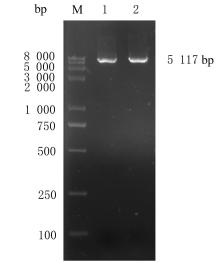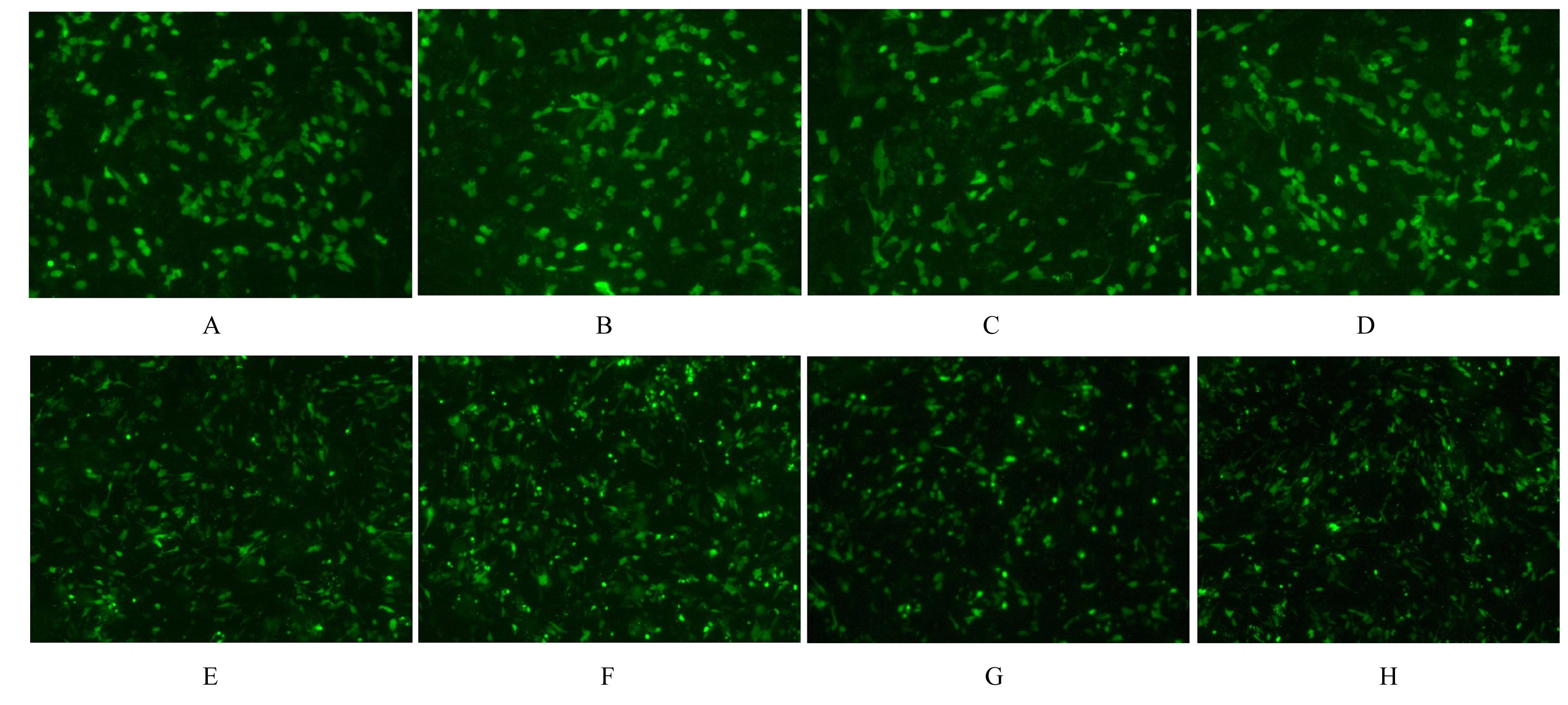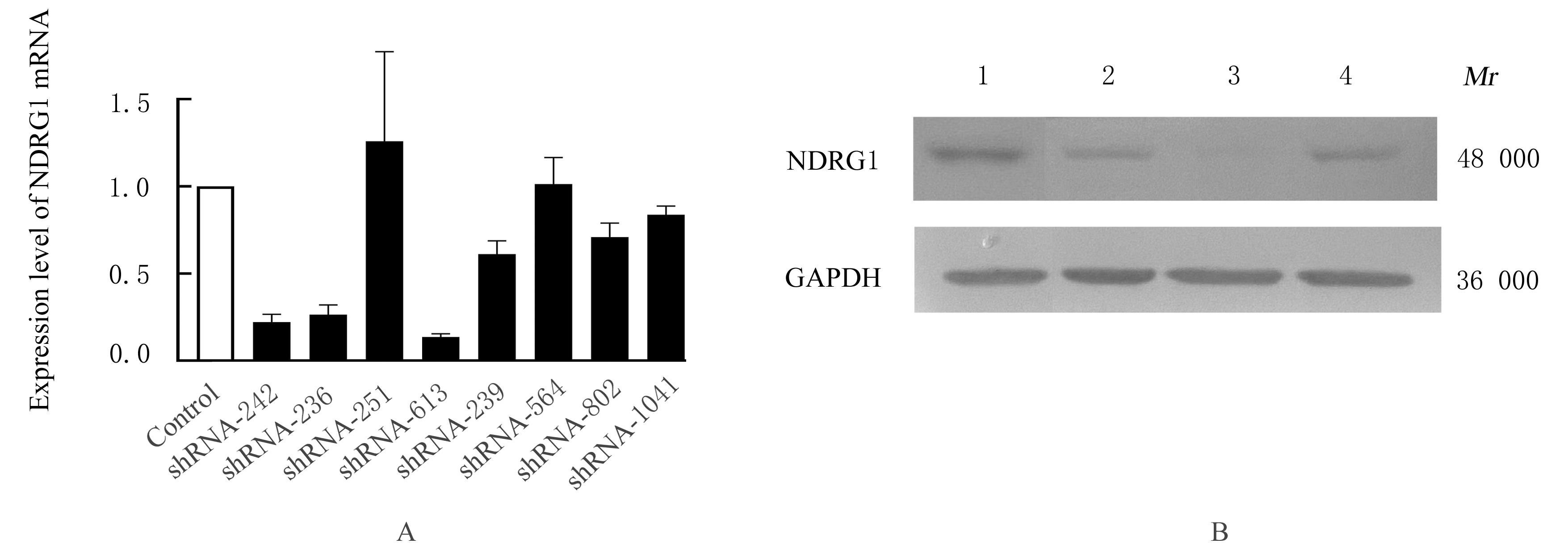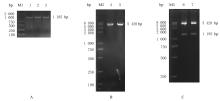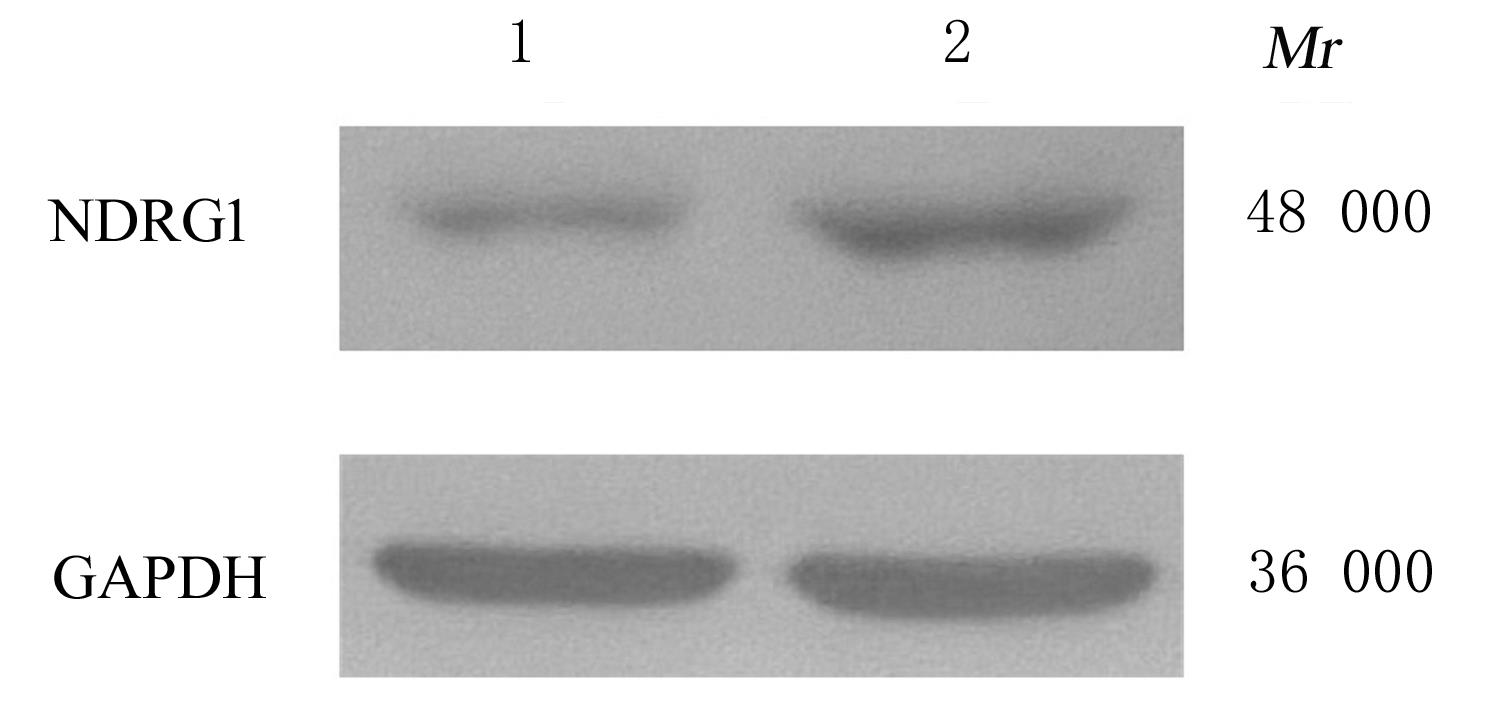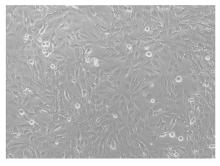Journal of Jilin University(Medicine Edition) ›› 2022, Vol. 48 ›› Issue (6): 1614-1622.doi: 10.13481/j.1671-587X.20220630
• Methodology • Previous Articles Next Articles
Construction of NDRG1 interference vector and establishment of human brain microvascular endothelial cells stably over-expressing NDRG1
Tingyu RUAN1,Weidi SHI1,Xun MA1( ),Jing WANG1(
),Jing WANG1( ),Lichao KANG2,Dongdong DU2,Yuelan YIN3
),Lichao KANG2,Dongdong DU2,Yuelan YIN3
- 1.Laboratory of Preventive Veterinary,College of Animal Science and Technology,Shihezi University,Shihezi 832003,China
2.Analysis and Test Center,Xinjiang Academy of Agricultural Reclamation Sciences,Shihezi 832000,China
3.Key Laboratory of Zoonosis,Jiangsu Province,Yangzhou 225009,China
-
Received:2022-02-03Online:2022-11-28Published:2022-12-07 -
Contact:Xun MA,Jing WANG E-mail:maxun779@126.com;wjtry100@163.com
CLC Number:
- R394.2
Cite this article
Tingyu RUAN,Weidi SHI,Xun MA,Jing WANG,Lichao KANG,Dongdong DU,Yuelan YIN. Construction of NDRG1 interference vector and establishment of human brain microvascular endothelial cells stably over-expressing NDRG1[J].Journal of Jilin University(Medicine Edition), 2022, 48(6): 1614-1622.
share this article
Tab. 1
Target sequences of shRNA vector of NDRG1 gene and annealed DNA Oligo sequences"
| Name | Target sequence | Annealed DNA Oligo sequence(5'-3') |
|---|---|---|
shRNA- NDRG1-236 | GGAGCAGGACATCG-AGACTTT | F:CACCGGAGCAGGACATCGAGACTTTCAAGAGAAGTCTCGATGTCCT-GCTCCTTTTTTG |
| R:GATCCAAAAAAGGAGCAGGACATCGAGACTTCTCTTGAAAGTCTCG-ATGTCCTGCTCC | ||
shRNA- NDRG1-242 | GGACATCGAGACT- TTACATGG | F:CACCGGACATCGAGACTTTACATGGTTCAAGAGACCATGTAAAGTC-TCGATGTCCTTTTTTG R:GATCCAAAAAAGGACATCGAGACTTTACATGGTCTCTTGAACCATG-TAAAGTCTCGATGTCC |
shRNA- NDRG1-251 | GACTTTACATGGC- TCTGTTCA | F:CACCGACTTTACATGGCTCTGTTCATTCAAGAGATGAACAGAGCCA-TGTAAAGTCTTTTTTG R:GATCCAAAAAAGACTTTACATGGCTCTGTTCATCTCTTGAATGAAC-AGAGCCATGTAAAGTC |
shRNA- NDRG1-613 | GCCTTGTCCTTAT- CAACGTGA | F:CACCGCCTTGTCCTTATCAACGTGATTCAAGAGATCACGTTGATAA-GGACAAGGCTTTTTTG R:GATCCAAAAAAGCCTTGTCCTTATCAACGTGATCTCTTGAATCACG-TTGATAAGGACAAGGC |
shRNA- NDRG1-239 | GCAGGACATCGAG- ACTTTACA | F:CACCGCAGGACATCGAGACTTTACATTCAAGAGATGTAAAGTCTCG-ATGTCCTGCTTTTTTG R:GATCCAAAAAAGCAGGACATCGAGACTTTACATCTCTTGAATGTAA-AGTCTCGATGTCCTGC |
shRNA- NDRG1-564 | GCCTACATCCTAA- CTCGATTT | F:CACCGCCTACATCCTAACTCGATTTCAAGAGAATCGAGTTAGGATGT-AGGCTTTTTTG R:GATCCAAAAAAGCCTACATCCTAACTCGATTCTCTTGAAATCGAGTT-AGGATGTAGGC |
shRNA- NDRG1-802 | GCAACCTGCACCT- GTTCATCA | F:CACCGCAACCTGCACCTGTTCATCATTCAAGAGATGATGAACAGGTG-CAGGTTGCTTTTTTG R:GATCCAAAAAAGCAACCTGCACCTGTTCATCATCTCTTGAATGATGA-ACAGGTGCAGGTTGC |
shRNA- NDRG1-1041 | GCTGAGGCCTTCA- AGTACTTC | F:CACCGCTGAGGCCTTCAAGTACTTCTTCAAGAGAGAAGTACTTGAAG-GCCTCAGCTTTTTTG R:GATCCAAAAAAGCTGAGGCCTTCAAGTACTTCTCTCTTGAAGAAGTA-CTTGAAGGCCTCAGC |
shRNA- NDRG1-NC | TTCTCCGAACGTG- TCACGT | F:CACCGTTCTCCGAACGTGTCACGTTTCAAGAGAACGTGACACGTTCGG-AGAATTTTTTG R:GATCCAAAAAATTCTCCGAACGTGTCACGTTCTCTTGAAACGTGACAC-GTTCGGAGAAC |
| 1 | 高 凡, 郑文亚, 刘 犇, 等. 单增李斯特菌穿越生理屏障机制的研究进展[J]. 中国人兽共患病学报, 2022, 38(1): 55-61. |
| 2 | MAURY M M, TSAI Y H, CHARLIER C, et al. Uncovering Listeria monocytogenes hypervirulence by harnessing its biodiversity[J]. Nat Genet, 2016, 48(3): 308-313. |
| 3 | 王 芳. N-myc下游调节基因1-NDRG1[J]. 昆明医科大学学报, 2014, 35(7): 1-4. |
| 4 | KITOWSKA A, PAWEŁCZYK T. N-myc downstream regulated 1 gene and its place in the cellular machinery[J]. Acta Biochim Pol, 2010, 57(1): 15-21. |
| 5 | BAE D H, JANSSON P J, HUANG M L, et al. The role of NDRG1 in the pathology and potential treatment of human cancers[J]. J Clin Pathol, 2013, 66(11): 911-917. |
| 6 | 徐冬冬, 王 韵, 章丽霞, 等. 小鼠宫颈癌组织放化疗前后NDRG1蛋白表达差异及预后意义[J]. 现代肿瘤医学, 2021, 29(20): 3522-3526. |
| 7 | 李成伟, 李圣青. N-myc下游调控基因1在呼吸系统疾病中的研究进展[J]. 复旦学报(医学版),2022,49(2): 282-288. |
| 8 | CAI K, EL-MERAHBI R, LOEFFLER M, et al. Ndrg1 promotes adipocyte differentiation and sustains their function[J]. Sci Rep, 2017, 7(1): 7191. |
| 9 | VILLODRE E S, GONG Y, HU X D, et al. NDRG1 expression is an independent prognostic factor in inflammatory breast cancer[J].Cancers, 2020,12(12): 3711. |
| 10 | 刘扬扬, 康立超, 马 勋, 等. 食源性单增李斯特菌LIPI-4基因的检测及序列分析[J]. 中国兽医学报, 2019, 39(12): 2380-2385. |
| 11 | ZHANG Y Y, DONG S L, CHEN H H, et al. Prevalence,genotypic characteristics and antibiotic resistance of Listeria monocytogenes from retail foods in bulk in Zhejiang Province, China[J]. Front Microbiol, 2019, 10: 1710. |
| 12 | CHEN Y T, CHEN M T, WANG J, et al. Heterogeneity, characteristics, and public health implications of Listeria monocytogenes in ready-to-eat foods and pasteurized milk in China[J]. Front Microbiol, 2020, 11: 642. |
| 13 | 刘扬扬, 康立超, 马 勋, 等. 食源性单核细胞增生李斯特菌毒力岛4携带株的分型、毒力及生物被膜形成能力的测定[J].中国预防兽医学报,2020,42(6):567-571. |
| 14 | 阮婷玉, 康立超, 刘扬扬, 等. 食源性单增李斯特菌毒力岛4基因缺失株的构建及其体外毒力研究[J/OL]. 中国动物传染病学报[2021-04-27].. |
| 15 | 李文艳, 陈滢滢, 董子怡, 等. 单增李斯特菌对小鼠滋养层细胞炎性体的激活[J]. 河北大学学报(自然科学版), 2022, 42(1): 73-77. |
| 16 | SALAMA P J, EMBAREK P, BAGARIA J, et al. Learning from listeria: safer food for all[J]. Lancet, 2018, 391(10137): 2305-2306. |
| 17 | LI W W, BAI L, FU P, et al. The epidemiology of Listeria monocytogenes in China[J]. Foodborne Pathog Dis, 2018, 15(8): 459-466. |
| 18 | LARKIN J, CHEN B S, SHI X H, et al. NDRG1 deficiency attenuates fetal growth and the intrauterine response to hypoxic injury[J]. Endocrinology, 2014, 155(3): 1099-1106. |
| 19 | SAHNI S, BAE D H, LANE D J R, et al. The metastasis suppressor, N-myc downstream-regulated gene 1 (NDRG1), inhibits stress-induced autophagy in cancer cells[J]. J Biol Chem, 2014, 289(14): 9692-9709. |
| 20 | 何宜静, 欧 琼, 李 婷, 等. 过表达NDRG1通过调控VEGF/sFlt-1轴增强缺氧条件下滋养细胞的促血管形成能力[J]. 安徽医科大学学报, 2020, 55(5): 745-750. |
| 21 | DAI X L, FU Y F, YE Y H. Increased NDRG1 expression suppresses angiogenesis via PI3K/AKT pathway in human placental cells[J]. Pregnancy Hypertens, 2020, 21: 106-110. |
| 22 | WATARI K, SHIBATA T, FUJITA H, et al. NDRG1 activates VEGF-A-induced angiogenesis through PLCγ1/ERK signaling in mouse vascular endothelial cells[J]. Commun Biol, 2020, 3(1): 107. |
| 23 | MERLOT A M, PORTER G M, SAHNI S, et al. The metastasis suppressor, NDRG1, differentially modulates the endoplasmic reticulum stress response[J]. Biochim Biophys Acta Mol Basis Dis, 2019, 1865(9): 2094-2110. |
| 24 | JIN W W, IBEAGHA-AWEMU E M, LIANG G X, et al. Transcriptome microRNA profiling of bovine mammary epithelial cells challenged with Escherichia coli or Staphylococcus aureus bacteria reveals pathogen directed microRNA expression profiles[J]. BMC Genomics, 2014, 15: 181. |
| 25 | LI X R, ZHANG P Y, WANG B B, et al. NDRG1 negatively regulates proliferation and Milk bio-synthesis of bovine epithelial cells via the mTOR signaling pathway[J]. Res Vet Sci, 2019, 124: 158-165. |
| 26 | 韩 帅, 陈 铭. 功能基因组学研究的技术方法[J]. 生命的化学, 2020, 40(3): 319-328. |
| [1] | Weiwei CHEN,Jiajia AN,Yan WU,Juanjuan DAI,Jing DU. Construction and identification of GLI1 eukaryotic expression vector and its effect on proliferation of lung cancer PC9 cells [J]. Journal of Jilin University(Medicine Edition), 2020, 46(6): 1150-1154. |
| [2] | WANG Mingyue, WANG Hao, WANG Dongmei, YANG Zebin, CUI Meiying, LIU Ning, HUANG Lili, GUAN Xingang. Construction of SIRPα-GFP eukaryotic expression vector and its expression in HEK293T cells [J]. Journal of Jilin University(Medicine Edition), 2020, 46(05): 925-929. |
| [3] | LI Shengnan, CHEN Wuhai, CHEN Shaofeng, DENG Fu, ZHU Peiyi, LI You. Construction of RHBDF2-shRNA lentiviral vector and establishment of stably transfected Neuro-2a-RHBDF2-shRNAcell line [J]. Journal of Jilin University(Medicine Edition), 2019, 45(06): 1224-1230. |
| [4] | YUE Yuan, XU Yinglian, WANG Jingjing, SUN Minying, ZHANG Zenan, ZHAO Xinyue, LI Zongpu, TAI Guixiang. Inhibitory effects of down-regulation of JNK enzymatic activity on growth of human prostate cancer cells, hepatocellular carcinoma cells and breast cancer cells [J]. Journal of Jilin University(Medicine Edition), 2019, 45(05): 1046-1051. |
| [5] | LIANG Chunmei, XU Xusan, YU Huajun, ZHOU Xia, WEN Xia, LI You, KOJIC Snezana, WANG Yajun, MA Guoda. Construction and identification of recombinant lentivirus overexpression and RNA interference vector containing cardiac adriamycin reactive protein gene [J]. Journal of Jilin University(Medicine Edition), 2019, 45(04): 766-771. |
| [6] | ZHU Wei, LI Guixian, CHENG Honglang, YIN Jinbao, JIANG Enping. Construction of CSF2A fusion gene recombinant eukaryotic expression vector and its effect on proliferation and apoptosis of EBV+ tumor cells [J]. Journal of Jilin University Medicine Edition, 2016, 42(03): 424-429. |
| [7] | WANG Dan, WANG Zhenyu, SHI Guang, YIN Guanghao. Construction of eukaryotic expression vector of TIMP-3 gene and its inhibitory effect on growth and invasion of MDA-MB-453 cells [J]. Journal of Jilin University Medicine Edition, 2016, 42(01): 89-93. |
| [8] | HUANG Zhili, ZHANG Lijun, WU Lihua, WANG Yan, YANG Rude. Influence of angiotensinogen gene silencing on differentiation of preadipocytes 3T3-L1 [J]. Journal of Jilin University Medicine Edition, 2015, 41(06): 1195-1200. |
| [9] | FANG Fang, ZHANG Wansheng, TANG Huayong, ZHAO Liangzhong, CHEN Shuang, LI Qiang, WANG Liguo. Influence of CD147 RNA interference in invasion of prostate cancer LNCaP-AI cells in vitro [J]. Journal of Jilin University Medicine Edition, 2015, 41(03): 460-463. |
| [10] | WANG Ke, ZOU Jiyan, WANG Li, DU Zhenwu, WANG Junrong, YE Cong, PAN Ying. Construction of RhoC lentivirus interference vector and its effect on expression of RhoC mRNA in ovarian cancer SKOV3 cells [J]. Journal of Jilin University Medicine Edition, 2015, 41(02): 304-306. |
| [11] | ZHANG Chengcai, SONG Yanyan, ZHOU Mengjiao, CUI Zhiqian, ZHANG Xichen, XING Shenyang. Effect of RNA interference of YWHAZ gene on proliferation of colon cancer HCT-8 cells [J]. Journal of Jilin University Medicine Edition, 2015, 41(02): 307-310. |
| [12] | LIU Chang, GAO Wei, FENG Xin. Therapeutic effect of RNA interfered STAT3 silence on collagen induced rheumatoid arthritis in rats [J]. Journal of Jilin University Medicine Edition, 2015, 41(01): 77-82. |
| [13] | ZHAO Jin-xia,WANG Zhi-ping,TAO Yan,HE Zhen-hua,GUO Qi,HONG Mei. Construction of human BTG2 eukaryotic expression vector with FLAG tag and its expression in HeLa cells [J]. Journal of Jilin University Medicine Edition, 2014, 40(06): 1149-1154. |
| [14] | JIANG Qing-hu,LUO Wei,WEN Lu,HU Hui-wen,DENG Da-wei,WU Zhong-jun. Expression of ARK5 in hepatocellular carcinoma tissue and its effect on growth of SMMC-7721 cells [J]. Journal of Jilin University Medicine Edition, 2014, 40(04): 743-747. |
| [15] | ZHANG Xia,ZHANG Xiu-mei,XIAO Jian-ying. Inhibitory effect of siRNA targeting CK2α gene on growth of HCT116 cells and its mechanism [J]. Journal of Jilin University Medicine Edition, 2014, 40(03): 621-625. |
|
